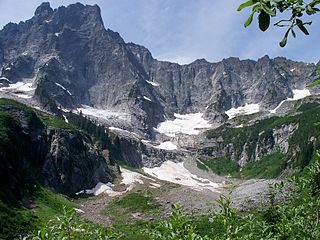| Upper Exum Ridge Route | |
|---|---|
| Exum Ridge Route | |
| Location | Grand Teton National Park, Wyoming, United States |
| Coordinates | 43°44′28″N110°48′07″W / 43.74110°N 110.802°W |
| Climbing Area | Grand Teton |
| Route Type | Trad |
| Vertical Gain | 4,000 feet |
| Pitches | 12 |
| Rating | 5.5 |
| Grade | II |
| First ascent | Glen Exum solo, 1931. |
The Upper Exum Ridge Route is the upper section of a technical rock climbing up the Grand Teton's Exum Ridge in Wyoming. [1]

Rock climbing is an activity in which participants climb up, down or across natural rock formations or artificial rock walls. The goal is to reach the summit of a formation or the endpoint of a usually pre-defined route without falling. Professional rock climbing competitions have the objectives of either completing the route in the quickest possible time or attaining the farthest point on an increasingly difficult route.

Grand Teton is the highest mountain in Grand Teton National Park, in Northwest Wyoming, and a classic destination in American mountaineering.
The Exum Ridge is the name of a prominent rock buttress on the Grand Teton, the high point of the Teton Range in Wyoming. Grand Teton towers 13,770 feet above Jackson Hole, with an ascent of 6,700 feet which by any route requires a combination of hiking, rock climbing and rappelling.
The route and ridge is named after Glenn Exum who pioneered the climb, via a solo ascent, on a day when his mentor Paul Petzoldt was guiding a couple up the original Owen-Spaulding Route. Today the route is split into the Upper and Lower Exum Ridge Routes. It is common for parties to bypass the more technically challenging lower section and climb exclusively the upper section. The Direct Exum Ridge Route which included both sections is recognized in the historic climbing text Fifty Classic Climbs of North America . [2]
Glenn Exum numbers among the premier mountaineers in American climbing history. Exum is best remembered for ascents in the Teton Range. In 1931, while only in his teens, Exum was the first to climb the exposed ridge to the summit of Grand Teton which now bears his name. The Exum Ridge remains one of the most popular routes to the summit of Grand Teton. After traveling Europe and seeing mountain guides there essentially pull their clients up the mountain, Exum, along with his friend Paul Petzoldt, founded a climbing school to teach clients climbing skills to allow them to fully participate in ascending the mountain. The school they founded, now known as Exum Mountain Guides, still operates today within Grand Teton National Park.
Paul Kiesow Petzoldt was one of America's most accomplished mountaineers. He is perhaps best known for establishing the National Outdoor Leadership School in 1965. Paul made his first ascent of the Grand Teton in 1924 at the age of 16, becoming the youngest person at the time to have done so. In 1938 Paul Petzoldt was a member of the first American team to attempt a climb on K2. For the climb he did not use assisted oxygen, he learned to use rhythmic breathing. He and Dan Bryant, from New Zealand, were the first climbers ever to traverse the Matterhorn twice in one day.
The Lower Exum Ridge Route is the lower section of a technical rock climbing route up the Grand Teton's Exum Ridge in Wyoming. This section is often bypassed on hiking terrain by climbers who wish to do only the technically easier Upper Exum Ridge Route. The complete route is listed as the Direct Exum Ridge Route in Fifty Classic Climbs of North America.
In 1931 Exum and Petzoldt started Exum Mountain Guides, which has grown to be a prestigious climbing school and mountain guide service. In 1982 Exum, accompanied by many distinguished mountaineers, made one last climb of the Exum Ridge route on the fiftieth anniversary of his first ascent.
The Exum Mountain Guides is a mountain guide service based in the U.S. state of Wyoming. The guide service was founded in the 1926 by Paul Petzoldt and Glenn Exum, for whom the Exum Ridge climbing route on the Grand Teton in Grand Teton National Park is named. From their base in Grand Teton National Park near Jenny Lake, Exum Mountain Guides provide guided climbing trips throughout the Teton Range and in other nearby mountain ranges. Numerous climbers have worked for the guide service, some of which pioneered new climbing routes on other mountains all over the world.









